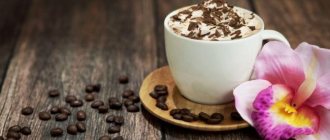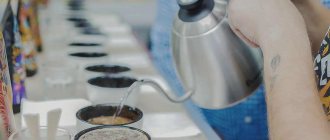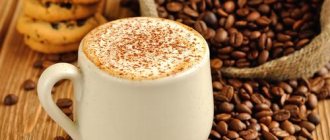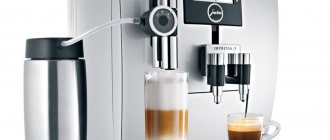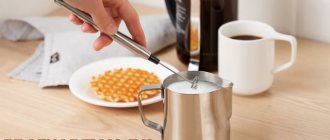Cappuccino is one of the most popular coffee drinks in the world. It is drunk in many countries, and the main thing in this process is to enjoy the slightly bitter coffee with thick milk foam and creamy notes. However, the birthplace of the drink is Italy, and they have their own “rules” for consumption. It will be useful for all coffee lovers to learn how to drink cappuccino correctly and try this drink at least once according to all Italian traditions.
What is the right time to drink cappuccino?
People in Italy drink cappuccino only in the first half of the day, believing that full-fat milk after lunch is harmful to proper nutrition and spoils the figure. Typically, pasticcerias do not serve it after lunch.
In the evening, it is customary to drink varieties of black coffee without sugar, but with substitutes. But they make an exception for tourists. In other countries, afternoon cappuccino is tolerated.
In America, they don’t even care what time to drink cappuccino.
But let's go back to basics and continue exploring Italian tastes.
Also, Italians never drink cappuccino with a large meal. It is believed that milk is a food that is consumed separately. You can eat something starchy with a cup of cappuccino, but never wash it down with your main meal.
Italians are very careful about their health and do not allow themselves to overload their stomach. In big cities they are already accustomed to the fact that tourists can drink cappuccino at any time of the day or night, but in small towns you will be persistently asked to think before drinking a cup of such coffee. And believe me, they will do this, taking care of your well-being.
General information
Cappuccino is a drink common in Europe and North America, consisting of several ingredients:
- Espresso
- Milk foam
- Milk
Characteristic:
- Homeland is Italy
- The name comes from the word cappuccino - capuchin
- Calorie content: 100 ml of drink contains 426 kcal. When using additional sweet additives, calorie content increases
It is believed that cappuccino was invented by the Capuchin monk Marco d'Aviano , who suggested adding a little milk to bitter, strong coffee to soften its taste. The resulting drink was so reminiscent of the brown robes of the Capuchins that it was decided to name it in their honor.
Varieties
In addition to the classic one, there are two more types of drink:
- Dry Cappuccino (dry cappuccino) - cappuccino without adding milk, with a little foam and whipped cream
- White cappuccino. In this option, frothed milk is poured into the cup first, and only then coffee.
Factors affecting taste
The taste and aroma of real cappuccino are significantly affected by:
- The type of coffee, its grinding and proper brewing. Since espresso is used to prepare cappuccino, you need to be able to prepare it correctly and from good beans. A finely ground mixture of Arabica and Robusta beans is best suited for brewing espresso. The volume of water for a shot of espresso should not exceed 50 ml, and the amount of coffee powder should be at least 7 grams
- You can also use instant espresso, but this product does not have such a rich taste and aroma as natural, freshly ground coffee.
- Quality and fat content of milk. Milk for cappuccino must be fresh, otherwise when heated it will turn sour and ruin the drink. In addition, it is better to take full-fat milk: it is better for creating foam. A low-fat product will produce a weak, quickly settling foam with large bubbles of a white-blue hue.
Fillers
To give cappuccino new shades of taste, milk foam is sprinkled with:
- Chocolate
- Cinnamon
- Sugar or powdered sugar
- Cocoa powder
- Confectionery sprinkles
- Nut crumbs
- Ground coffee
- Spices
What do you usually eat with cappuccino?
As a rule, after ordering a cappuccino, locals do not eat anything. Only hearty coffee makes up their breakfast. Having quickly drunk a cappuccino and satisfied their morning hunger, they again run about their business. But, if you have time and want to sit in a cafe, then the choice of antipasto is varied:
- warm morning pastries, cream croissants are the most popular pastries. These croissants are made from soft puff pastry with custard inside.
- donuts with powdered sugar, there are empty donuts, but in most cases with fruit or caramel filling.
- all kinds of cookies, with the addition of nuts, candied fruits, cheese.
- Brownie is not a very popular dessert with cappuccino, since together it turns out to be a calorie bomb, but nevertheless it has a place because it is very tasty.
- Tiramisu is a classic Italian dessert, so it’s definitely worth a try.
Cappuccino proportions and preparation rules
An important component of a cappuccino is the properly frothed milk that is poured into the espresso. To make the foam ideal, the temperature of the milk we take for whipping should be +4°C. It is better to take pasteurized rather than homemade milk, 2.5-3.5% fat.
Cappuccino coffee consists of 1/3 espresso, 1/3 hot milk and 1/3 milk foam. A standard serving of cappuccino is five to seven ounces, or 150-180 milliliters. To prepare, frothed milk is poured into espresso.
The milk foam on top of the drink acts as an insulator and helps keep the temperature high longer.
Properly prepared cappuccino is drunk without sugar; it is tasty due to the natural sweetness of the milk, which the milk acquires when heated to 60-65°C.
Proportions of milk and espresso in cappuccino and latte.
Here it is worth talking about the differences between cappuccino and latte, but we discussed this issue in detail in the description of latte.
Proper serving of cappuccino
You are now hoping for the right cappuccino recipe, but alas, it does not exist in nature. Everyone has different types of coffee and quality of milk, so it won’t be possible to bring the recipe to the same denominator. Everyone prepares the drink to their own taste.
The main rule is to whisk the milk well so that the foam is stable and does not immediately dissolve in the coffee. The ratio of coffee and milk is the same. When foaming, milk increases in size and three layers are formed in the cup - coffee, milk and foam in equal quantities.
Sugar is not added, as the taste of the milk becomes sweet when churned. The serving temperature is 60-70 degrees, so as not to burn the oral mucosa.
A special container for the drink is a ceramic cup with thick walls, similar to an espresso cup, only larger in volume. The cup is preheated so that the coffee does not cool down and the foam lasts longer.
How to froth milk correctly
To get a proper cappuccino, it is extremely important to create a thick froth. To achieve this result, it is recommended to use full-fat milk. The higher its fat content, the better the drink will be. You can use cream and mix it with milk.
The easiest way to create foam is to use a coffee machine
At the same time, it is not at all necessary to buy expensive units with a cappuccino function. Absolutely any model equipped with a steam pipe can be used. The cooking technology is as follows:
- Turn on the steam to remove any remaining liquid from the tube.
- Pour the milk into a deep container with a wide neck.
- Tilt the dish slightly and place it under the spout of the pipe.
- Turn on steam. At the same time, increase the power gradually.
- Carry out the whisking procedure on the surface of the milk, without plunging the spout deeper. Otherwise, the liquid will begin to boil and the desired result will not be achieved.
You can use a hand mixer. The beating procedure will be as follows:
- Pour milk into a saucepan or ladle.
- Place the container on the stove and begin the whipping process. The mixer should operate at maximum speed.
- Do not allow it to boil.
- Immediately after thick foam appears, remove the dishes from the stove.
You can whip the foam by hand, but it will take much more time. For this method it is best to use cream. Perform the following manipulations:
- The cream is poured into a wide container and heated in a water bath.
- When they heat up to a temperature of 50 degrees, they begin to beat with a whisk, performing movements as quickly as possible.
- The procedure is stopped immediately after foam appears.
conclusions
- It is recommended to drink cappuccino in the first half of the day, take care of your health.
- Do not drink cappuccino after a heavy meal; the drink contains a portion of milk, and milk is equivalent to food.
- The cup should be warmed up, and the coffee in it should be 60-70 degrees. Tall glasses are not suitable for proper cappuccino.
- Drink coffee immediately after preparation, do not wait until it cools down.
- Do not stir the drink, start drinking straight from the thick foam. Let it harden on your lips and you will feel how nice the air bubbles burst.
But the client is always right?
Of course, you can prove this well-known formula and demand your rightful hot cappuccino. And have no doubt: they will make it for you, and you will walk down the street with a glass that burns your fingers. However, do not expect from this drink the same creamy foam and pleasant sweetness for which cappuccino is so loved all over the world.
Well, if you drink coffee in an establishment, a wise barista, in order not to spoil the taste of the drink, will simply warm up the cup before pouring the cappuccino into it.
What to do if you want your favorite coffee to be tasty and at the right temperature?
There are two options. The first and simplest is to drink cappuccino immediately after preparation. Then the temperature will be optimal, the aroma and taste of coffee will be pronounced, the sweetness will be moderate, and the foam will be tender and voluminous.
The second option is for those who prefer coffee to go. Take a thermal mug with you and ask the barista at the coffee shop to pour the cappuccino straight into it. The ideal foam in it, of course, will not last long, but the drink will not cool down for several hours. This method is also excellent from an environmental point of view: it is known that disposable cups and lids do not decompose for many decades and risk becoming the most common trace that our civilization will leave behind. In addition, many chain coffee shops offer discounts on drinks poured into visitors’ mugs. So this is also a saving.
Preparing cappuccino
If you have a coffee machine at home, then you don’t need to be an expert in making cappuccino. The coffee machine program includes different types of coffee, including cappuccino. But the beauty of making coffee is by hand.
To prepare one serving you will need:
- Ground coffee – 2-3 teaspoons;
- Water – 250 ml;
- Sugar – 2-3 tsp;
- Milk - 3.5% - 6% - 70 ml;
- Cinnamon.
To froth milk, it is better to take a whole and natural product. If there is no fat milk, then you can use 10% cream. The foam from the cream is denser and higher, but it does not diffuse as well with the coffee. After all, cappuccino is the diffusion of foamed milk throughout the entire depth of the drink.
A geyser coffee maker is best suited for espresso. But, you can use a regular Turkish press and a French press. It is recommended to strain Turkish coffee, as espresso should not contain sediment.
You need to pour water into the lower compartment of the geyser coffee maker to a certain level. Then you need to install the filter and add coffee. Stronger espresso is obtained if the filter is tightly filled with ground beans. Now you need to close the coffee maker and put it on low heat. Readiness is determined by the stop of hissing from the coffee maker. It must be immediately removed from the heat at this moment.
Milk foam is excellent when frothing milk in a mixer. To do this you need to warm it up a little. A French press also whips milk foam well. You should get a light, air-rich foam that will not disappear from the surface of the cup until the last sip of the drink. By combining espresso with milk foam, we get cappuccino. Sprinkle the foam with cinnamon on top.
Difference in cooking process
Despite the similar composition, the development of the production of drinks is very different.
There are several methods you can use to make a latte: latte macchiato and traditional latte. To make the first one, it is recommended to pour previously heated milk or its mixture with cream into a glass, and then add coffee. As for the traditional version, it is prepared like cappuccino, only the proportions are different. Foam can be added before pouring in the espresso or added at the very end. Before this, lattes were not stirred, but sought to achieve a layered structure; now the trend is for a homogeneous drink, so mixing is allowed.- To make cappuccino, pour a portion of coffee into a container, then add milk that has previously undergone the frothing process, and spread the resulting foam on top. It is not customary to stir the drink.
How to drink cappuccino
In Italy, they prefer to drink cappuccino with foam and like to leave it on the lips. This is how Italians kill two birds with one stone - they appreciate both the bitter taste of coffee and the notes of milk foam.
Cappuccino can be drunk through a straw. The layers are mixed. In this case, the drink is served in a tall glass. This option is acceptable for latte.
If granulated sugar is added to the cup, the drink has to be stirred. However, this eliminates the contrast between the flavors of Arabica and milk.
You can serve toast with honey, chocolate, and vanilla-caramel syrup with cappuccino. It is not recommended to combine cappuccino with fruity notes. The drink is also consumed separately, without any culinary delights.
The taste of coffee is perfectly complemented by vanilla, cinnamon, and nutmeg. Spices are added either directly to coffee or to foam. It is not recommended to stir coffee unless you add granulated sugar.
The nuances of coffee consumption
The usual approach calls for drinking before noon. Italians are convinced that these are morning drinks because they contain milk. If you familiarize yourself with Russian information channels, there are no strict restrictions, there are only tips.
How to drink a latte:
- Suitable for consumption between meals, as it can be worn out in huge volumes.
- There is not enough caffeine in its composition, so you can drink it even in the evening.
- Usually, a napkin, spoon and straw are served with the glass. We hold the glass with a napkin so as not to burn ourselves, stir the drink with a spoon, and drink with a straw.
- Fruit and curd flavors are in amazing harmony with the taste of latte. Cheesecakes, soufflés and mousses are the perfect addition to the drink.
- The delicate palette of the drink is stunningly complemented by nut-flavored sweets or chocolate ice cream.
- If you prefer low-calorie desserts, it is recommended to pay attention to raspberry sorbet, strawberry pudding or fruit marshmallow.
For cappuccino lovers:
- The composition contains a high concentration of caffeine, so they should complete a light lunch or snack.
- They drink it through foam. The delicate milky flavor helps bring out the unique bitter taste of espresso.
- It is not customary to stir cappuccino; it is a sign of bad taste.
- In order to more fully experience the versatility of the taste, adding sugar to the drink is contraindicated.
- Creamy and chocolate flavors blend amazingly with cappuccino. Buttercream, panna cotta and brownies are perfect.
- If you like to treat yourself to unusual desserts, we recommend that you pay attention to peach mousse or coconut cookies.
- If you have to count calories, then choose meringue or strawberry jelly - desserts that are virtually fat-free.
The history of coffee is very rich. Now this is a trend, as it was many years ago, because every connoisseur is offered a huge number of types of coffee: Americano, mochaccino, glasse, raf and simple instant drinks, for example, coffee white. They are made using different methods, so try and choose.
Making cappuccino in a coffee machine is a new life for your coffee lover.
Interesting facts about cappuccino
Finally, we want to tell you some interesting facts about the cappuccino drink:
- As you already know, coffee was prohibited, so the abbot of the monastery where the drink was drunk was summoned by the Pope himself. To avoid severe punishment, the abbot prepared a cappuccino for the Pope. My father highly appreciated the taste and aroma of this drink, so he lifted the ban on its use.
- Cappuccino keeps teeth healthy and prevents coffee pigment from leaving marks on the enamel. Therefore, you don’t have to worry about your snow-white smile.
- Italians drink cappuccino in the morning during breakfast. Drinking a drink after dinner is considered bad manners, so it is believed that only tourists can afford it.
- In 2012, the largest cup of cappuccino was prepared in Zagreb. The volume of the drink was 2 thousand liters, and 22 coffee machines were used to prepare it.
We hope you learned a lot from our article. Perhaps you also know interesting facts about your favorite drink? If yes, then tell us about them in the comments.
The history of cappuccino coffee
Everyone's favorite drink appeared quite a long time ago, so it is difficult to say who created it and when. But today there are several popular versions about the origin of the legendary cappuccino.
The first story says that the drink itself, as well as its name, appeared in the 16th century in Italy. The name cappuccino comes from the name of the cassock of the Capuchin monks. The hood of the clothes was similar to the color of the drink. By the way, in Italian the name of the hood is “cappuccio”.
In those days, coffee was considered a devilish drink and was banned by the Catholic Church. This was explained by the fact that the drink was invigorating and very attractive. But some monks sometimes “pampered” themselves with coffee by adding heavily frothed milk. Since milk was considered a “light” drink, the monks thought that with its help they could “purify” the forbidden coffee.
Another story tells that the idea of creating cappuccino belongs to one of the monks of the Capuchin order. After the battle with the Turks near Vienna in 1683, Marco d'Aviano found bags of coffee beans and decided to make himself a drink. He didn't like the bitter taste of the coffee, so he added cream and honey, which turned the mixture into a light brown color. It resembled the color of Capuchin robes, so the Viennese began to call it cappuccino.
Cappuccino in its modern form came to us in 1855. It was at this time that Edward Lawsell de Santais presented his coffee machine at an exhibition in France and used it to prepare cappuccino. Since then, the drink has spread throughout the world and gained immense popularity.
